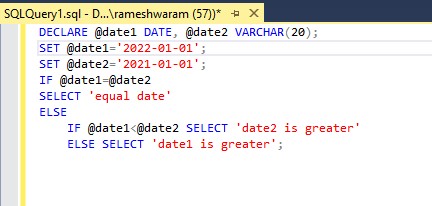Comparing dates in SQL is a fundamental skill for any database developer. Understanding how to effectively use comparison operators and functions to analyze date-based data is crucial for tasks like filtering records, scheduling events, and generating reports. This article provides a comprehensive guide on how to compare dates in SQL, covering various techniques and scenarios.
Understanding Date Datatypes
SQL supports several date and time datatypes, including DATE, DATETIME, TIMESTAMP, and others. The DATE datatype stores only the date (year, month, day) without the time component, typically in ‘YYYY-MM-DD’ format. When working with dates that include time, the DATETIME datatype is commonly used.
Comparison Operators
The simplest way to compare dates in SQL is using standard comparison operators:
=(Equals): Checks if two dates are identical.!=or<>(Not Equals): Checks if two dates are different.>(Greater Than): Checks if the first date is later than the second date.<(Less Than): Checks if the first date is earlier than the second date.>=(Greater Than or Equals): Checks if the first date is later than or equal to the second date.<=(Less Than or Equals): Checks if the first date is earlier than or equal to the second date.
These operators can be used directly with date values or variables.
Using IF-ELSE Statements for Date Comparisons
Conditional logic using IF-ELSE statements allows you to perform different actions based on the outcome of a date comparison.
IF @date1 = @date2
SELECT 'equal date'
ELSE IF @date1 < @date2
SELECT 'date2 is greater'
ELSE
SELECT 'date1 is greater';In this example, @date1 and @date2 are variables representing the dates being compared. The IF-ELSE block determines which message to display based on the comparison result.
Declaring and Setting Date Variables
Before performing comparisons, you need to declare and assign values to date variables.
DECLARE @date1 DATE, @date2 DATE;
SET @date1 = '2021-01-01';
SET @date2 = '2021-02-02';This code snippet declares two variables of type DATE and initializes them with specific date values.
Comparing Dates with Different Datatypes
SQL can implicitly convert some datatypes for comparison. For example, comparing a DATE variable with a VARCHAR variable containing a valid date string will often work:
DECLARE @date1 DATE, @date2 VARCHAR(20);
SET @date1 = '2021-01-01';
SET @date2 = '2021-01-01';
IF @date1 = @date2
SELECT 'equal date';However, relying on implicit conversion can sometimes lead to unexpected behavior. It’s generally recommended to ensure both values being compared have the same datatype.
Practical Examples
Let’s examine a few examples illustrating different date comparison scenarios.
Example 1: Checking for Equal Dates
DECLARE @date1 DATE, @date2 DATE;
SET @date1 = '2021-01-01';
SET @date2 = '2021-02-02';
IF @date1 = @date2
SELECT 'equal date'
ELSE
SELECT 'dates are not equal';Output:
Example 2: Checking if a Date is within a Range
DECLARE @targetDate DATE;
SET @targetDate = '2023-05-15';
IF @targetDate >= '2023-05-01' AND @targetDate <= '2023-05-31'
SELECT 'Date is within May 2023';
ELSE
SELECT 'Date is not within May 2023';Example 3: Comparing Dates with Different Datatypes
DECLARE @date1 DATE, @date2 VARCHAR(20);
SET @date1 = '2022-01-01';
SET @date2 = '2021-01-01';
IF @date1 > @date2
SELECT 'date1 is greater';
ELSE
SELECT 'date2 is greater or equal';Output:
Conclusion
Comparing dates in SQL involves understanding datatypes, utilizing comparison operators, and leveraging conditional logic. By mastering these techniques, you can efficiently query and analyze data based on date criteria, enabling a wide range of database operations. Remember to consider datatype consistency and potential implicit conversions for accurate and reliable results.
